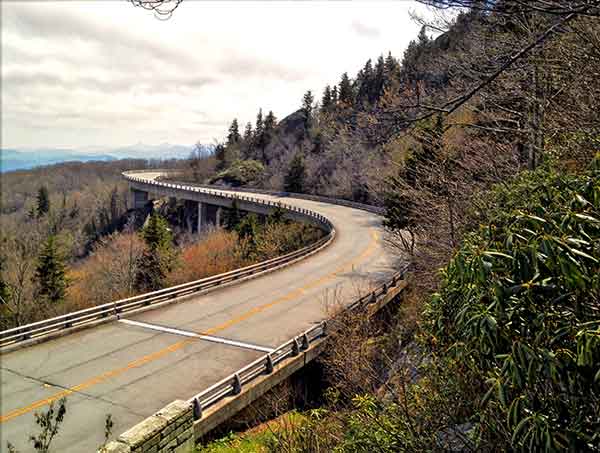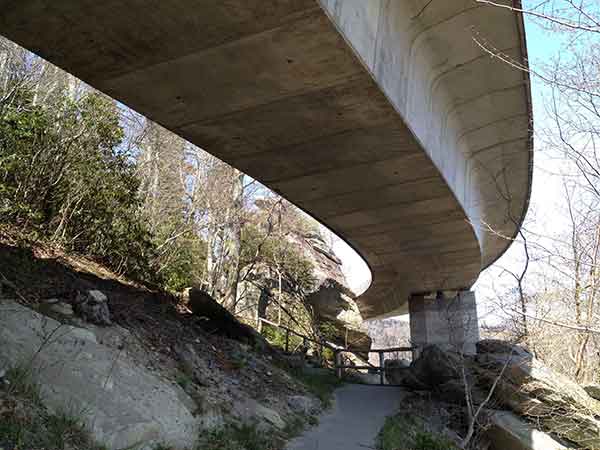Linn Cove Viaduct
The Linn Cove Viaduct on the Blue Ridge Parkway is an international engineering marvel. The Linn Cove Viaduct was completed in 1987 at a cost of $10 million and was the last section of the Blue Ridge Parkway to be finished. The Linn Cove Viaduct a 1243-foot concrete segmental bridge hugs and curves around the face of Grandfather Mountain with a view of the Blue Ridge Mountains that is second to none. To ride across and get a close look at this engineering marvel, drive north on the Parkway for 78 miles from Asheville to Milepost 304.
Engineering a Blue Ridge Marvel
The viaduct was needed because of the damage that a traditional cut-and-fill road would have caused to Grandfather Mountain. The viaduct was designed by Figg and Muller Engineers, Inc.; construction began in 1979. It is 1,243 feet long and consists of 153 segments weighing 50 tons each. The bridge’s segments were precast at an indoor facility at the south side of the parkway. After being transported to the bridge site, each section was lowered into place by a custom crane placed on either edge of the existing structure. The only work done at ground level was drilling for the seven footings which support the viaduct. In particular, there was no access road other than the Blue Ridge Parkway itself. The bridge has received eleven design awards.
The National Park Service maintains a visitor center and bridge museum at the south end of the viaduct. At the Linn Cove Visitor Center there is a model of the construction technique highlights where you can explore the bridge museum. The Tanawha Trail passes by the Linn Cove Visitor Center, and it travels beside and underneath the viaduct, on its route from Beacon Heights to Julian Price Memorial Park.
Hiking Under and Above the Viaduct
Take a about a one-mile round trip hike for an up close view of this engineering marvel. An accessible paved trail begins at the visitor center and leads to a beautiful view of the viaduct from underneath, and gives hikers access to the Tanawha Trail. The Tanawha Trail is a 13.5 mile long trail that more or less runs parallel to the Parkway from Beacon Heights Parking Area at mile marker 305.5 to Price Lake at mile marker 297.
Linn Cove Viaduct-Tanawha Trail
Probably one of the most interesting hikes I have been on yet. Starting from the Linn Cove Viaduct Visitor Center milepost 304.6 off the Blue Ridge Parkway. As you travel through the parking lot to the trail head which takes you on a nice pleasant walk under the viaduct where you can gaze at the amazing modern marvel of construction and hear the many cars traveling overhead. This very short hike is about 900 feet.
Amazing View on the Tanawha Trail
This is a small section is part of the Tanawha Trail which is 13.5 miles long in total distance winding along the Blue Ridge Parkway mountains. For the more adventurous looking for an amazing picture opportunity and seeing the whole viaduct…this is the trail for you. Continue up the wooden stairs as the trail winds up and down through a maze of rocks, boulders, and rock staircases. This is one of the most different types of trails I have been on. I would recommend if kids are going they are at least ages 5 and up and accompanied by an adult on either side. There are some slight drop offs along the trail. There is even one part that you are traveling through the rocks almost like a tunnel. Along the trail there is a bridge where Wilson’s Creek runs under and a pretty coll waterfall to see. As you near the end of the viaduct about an hour later there is a fork in the road; take the fork with the red ribbon to the right. The trail going straight continues as part of the Tanawha Trail. The red ribbon indicates you have made it to one of the most distinctive picture taking points of the Blue Ridge Parkway. You have seen this vantage point in many pictures and magazines about the Blue Ridge Parkway Not only will you be elevated above the parkway but above the viaduct watching cars come around the bend as they travel over the viaduct.




